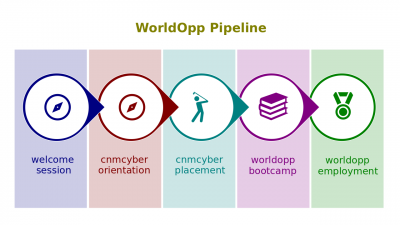Difference between revisions of "Work Arrangements"
MariamKhalid (talk | contribs) (→Placement entrance exam) |
(→Lectio quiz) |
||
| Line 28: | Line 28: | ||
==Questions== | ==Questions== | ||
| − | |||
| − | |||
| − | |||
| − | |||
===Placement entrance exam=== | ===Placement entrance exam=== | ||
Revision as of 02:15, 10 October 2020
Work Arrangements (hereinafter, the Lectio) is the second lesson part of the Nature of Work lesson that introduces its participants to work characteristics and related topics.
This lesson belongs to the Introduction to Employment session of the CNM Cyber Orientation. The Orientation is the second stage of the WorldOpp Pipeline.
Content
The predecessor lectio is Work Characteristics.
Key terms
- Work arrangement. An agreement to arrange one's work schedule, method, or load.
- Compressed workweek. A workweek where employees work longer hours per day but fewer days per week.
- Flextime (or flexible work hours). A scheduling system in which employees are required to work a specific number of hours a week but are free to vary those hours within certain limits.
- Telecommuting. Working remotely at least 2 days a week on a computer that is linked to the employer's office.
- Job sharing. (1) An arrangement that allows two or more individuals to split a full-time job; (2) The practice of having 1).
Script
- Work arrangement is an agreement, usually an employment agreement, to arrange employees's work schedule, method, or workload. Some arrangements such as a compressed workweek, flextime, telecommuting, and job sharing touch both job characteristics and work-life fit.
- A compressed workweek is a workweek where employees work longer hours per day but fewer days per week. Instead of eight hours a day for five days, the compressed workweek often is ten hours per day for four days.
- Flextime represents flexible work hours. Employees are required to work a specific number of hours a week, but are free to vary those hours within certain limits.
- Telecommuting is work from a remote location. Routinely, an employee works remotely at least 2 days a week on a computing device that is linked to the software systems that the employer controls.
- Job sharing is the arrangement that allows two or more individuals to split a full-time job.
Job Dimensions is the successor lectio.
Questions
Placement entrance exam
- "Fit" questions:
- In one's job, duration of typical workweek refers to number of hours typically worked in one week.
- Duration of typical workweek is (not) a structural job characteristic.
- Work schedule is (not) a structural job characteristic.
